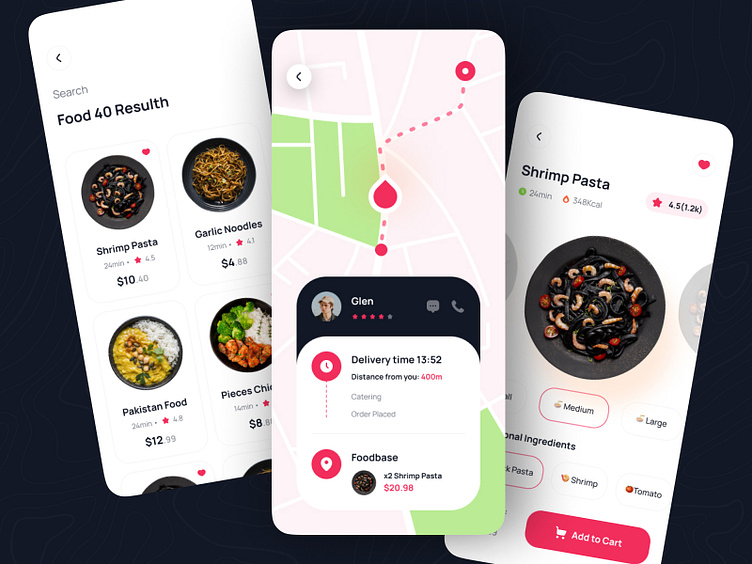Food mobile application
A Food App is a platform designed to simplify food-related activities such as ordering meals, reserving tables, managing diets, or exploring recipes. It caters to a broad range of use cases, including food delivery, grocery shopping, meal planning, or restaurant discovery. Below is a detailed guide to building a Food App, including essential features, technology stack, and monetization strategies.
Key Features of a Food App:
1. User Registration and Profiles
Sign-Up/Login:
Allow users to register using email, phone numbers, or social media accounts.
Provide biometric authentication (Face ID, fingerprint) for quick and secure login.
User Profiles:
Store user preferences, dietary restrictions, delivery addresses, and payment methods.
Guest Checkout:
Allow users to place orders without registering for faster onboarding.
2. Restaurant and Food Listings
Browse and Search:
List restaurants, food categories, or grocery items with search and filtering options (e.g., cuisine, price, dietary preferences).
Menu Display:
Include detailed menus with descriptions, images, ingredients, and pricing.
Favorites:
Let users save favorite restaurants, dishes, or recipes for quick access.
Nearby Options:
Use geolocation to display nearby restaurants or grocery stores.
3. Food Delivery
Order Customization:
Allow users to customize their orders (e.g., toppings, spice levels, portion sizes).
Real-Time Tracking:
Integrate GPS tracking for users to monitor their order’s status in real-time.
Delivery Time Estimates:
Provide accurate delivery time predictions based on restaurant preparation and distance.
Contactless Delivery:
Enable users to opt for no-contact delivery for safety.
4. Table Reservation (Optional)
Real-Time Availability:
Display available time slots and seating capacity for restaurants.
Booking Management:
Allow users to book, modify, or cancel reservations with ease.
Special Requests:
Let users add notes for special occasions or dietary needs.
5. In-App Payments
Multiple Payment Options:
Support credit/debit cards, digital wallets (e.g., PayPal, Apple Pay), and cash on delivery.
Saved Payment Methods:
Allow users to securely save payment details for faster transactions.
Split Bills:
Provide a feature to split bills among multiple users for group orders.
6. Reviews and Ratings
Restaurant and Dish Reviews:
Let users leave feedback and rate restaurants or dishes they’ve tried.
Verified Reviews:
Display reviews only from users who’ve placed orders for authenticity.
Photo Uploads:
Allow users to share photos of dishes or experiences.
7. Push Notifications
Order Updates:
Notify users about order confirmation, preparation, and delivery status.
Promotions and Discounts:
Alert users about special offers, discounts, or limited-time deals.
Reminders:
Send notifications for scheduled orders, upcoming reservations, or loyalty points expiration.
8. Loyalty and Rewards
Points System:
Reward users with points for every order, which can be redeemed for discounts or freebies.
Referral Program:
Offer rewards for referring friends to the app.
Exclusive Memberships:
Provide premium users with benefits like free delivery, priority reservations, or exclusive discounts.
9. Dietary and Nutrition Features
Dietary Filters:
Allow users to filter options by dietary preferences (e.g., vegan, gluten-free, keto).
Calorie Tracking:
Display calorie counts and nutritional information for dishes or recipes.
Meal Plans:
Suggest personalized meal plans based on dietary goals.
10. Admin Panel
Restaurant Management:
Allow restaurant partners to update menus, track orders, and manage availability.
Order Monitoring:
Provide admins with real-time visibility into orders and delivery statuses.
Analytics Dashboard:
Show insights into app usage, top-performing restaurants, and revenue trends.
Promotions Management:
Enable admins to create and manage app-wide discounts or campaigns.
Advanced Features for a Food App:
AI-Powered Recommendations:
Use AI to suggest dishes or restaurants based on user preferences and order history.
Voice Search:
Allow users to search for restaurants or dishes using voice commands.
Augmented Reality (AR):
Enable users to visualize dishes or restaurant interiors with AR.
Group Orders:
Let multiple users collaborate on an order before checkout.
Subscription Services:
Offer meal subscription plans for daily or weekly deliveries.
Technology Stack for a Food App:
Frontend Development:
Languages: HTML5, CSS3, JavaScript.
Frameworks: React.js, Angular, or Vue.js for web; Flutter, React Native for mobile apps.
Backend Development:
Languages: Node.js, Python (Django/Flask), Ruby on Rails.
Database: MongoDB, PostgreSQL, MySQL.
APIs:
Maps and Geolocation: Google Maps API for delivery tracking.
Payment Gateways: Stripe, PayPal, Razorpay for secure payments.
Push Notifications: Firebase Cloud Messaging, OneSignal.
Infrastructure:
Hosting: AWS, Google Cloud, Microsoft Azure.
CDN: Cloudflare, AWS CloudFront for faster content delivery.
Encryption: TLS/SSL for secure data transmission.
Monetization Strategies:
Delivery Fees:
Charge users a fee for food delivery, with options for premium services like faster delivery.
Restaurant Commissions:
Earn a percentage of every order placed through partner restaurants.
In-App Advertising:
Allow restaurants to pay for promoted listings or banner ads.
Subscription Plans:
Offer paid memberships with perks like free delivery, exclusive discounts, and priority support.
Sponsored Listings:
Feature restaurants or grocery stores in prominent sections of the app for a fee.
Best Practices for Developing a Food App:
Focus on Usability:
Design an intuitive user interface that makes ordering, tracking, and paying effortless.
Optimize for Speed:
Ensure fast load times and smooth navigation, especially during peak hours.
Ensure Scalability:
Build a backend capable of handling high traffic during promotions or meal times.
Prioritize Security:
Use robust encryption for payment data and ensure compliance with data protection regulations.
Gather Feedback:
Continuously improve by collecting user feedback on features and usability.
Example Use Case Scenarios:
Food Delivery:
Simplify ordering meals from local restaurants with real-time delivery tracking.
Grocery Delivery:
Provide fresh groceries delivered directly to users’ doorsteps.
Meal Planning:
Help users create weekly meal plans based on dietary goals and preferences.
Restaurant Discovery:
Allow users to find and book tables at new or popular restaurants in their area.
Conclusion:
A Food App combines convenience, personalization, and interactivity to cater to modern consumer needs. Whether focusing on delivery, grocery services, or meal planning, your app can stand out by integrating AI-powered recommendations, real-time tracking, and a seamless ordering experience. Prioritize scalability, security, and user experience to build a successful platform that keeps users coming back.
💬 Let’s discuss!
I’m online in Telegram and Discord to discuss your project:
Telegram: http://t.me/doctordesign
Discord: https://discordapp.com/users/r.koohi99#8459
LinkedIn: www.linkedin.com/in/rooholla
Email: Hi@roohi.pro
